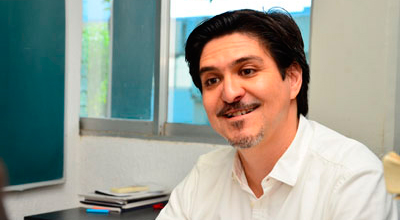
(1).jpg) One of the five projects approved by the National Council for Science and Technology in recent days, in partnership with the European Research Council ERC, was the one proposed by the research professor of the Sciences School of the University of Colima, Andrés Pedroza, who will conduct a research stay for seven months at the Tel Aviv University in Israel, in order to study one of the newest mathematical topics at the present time: the symplectic geometry.
One of the five projects approved by the National Council for Science and Technology in recent days, in partnership with the European Research Council ERC, was the one proposed by the research professor of the Sciences School of the University of Colima, Andrés Pedroza, who will conduct a research stay for seven months at the Tel Aviv University in Israel, in order to study one of the newest mathematical topics at the present time: the symplectic geometry.
With evident enthusiasm, the Doctor in Mathematics, Andrés Pedroza, noted that it is a much-awaited opportunity in an important moment for his academic and personal development: "I like Mathematics and working on symplectic geometry; if I'm given the opportunity to do it, I feel really good," he said. Andrés Pedroza explained that his project is purely scientific, and it is called "Hamiltonian Isotopy of Lagrangian Subvarieties in Symplectic Explosions," and will be conducted in conjunction with a recognized work team of the Russian-Israeli mathematician, Leonid Polterovich: "I will exchange ideas with doctoral students and collaborators from the post doctorate, who work in these leading-edge topics," he specified.
He explained that the symplectic geometry is an area of Mathematics which is very active today. "For the mathematicians, there is a great motivation and interest in studying certain symmetries of very particular objects, called symplectic. The sphere is one of those, whose symmetry we understand well, because when we rotate it, it looks the same from either side". However, he continued, "the symplectic geometry studies more abstract objects that we cannot draw in a three dimensional space, and we want to understand how these symmetries are formed, which is also of interest to science," he added.
To this mathematical stage, he added the element of the object's rotary axes, which refer to fixed points: "As mathematicians, we want to know which objects do not move under certain symmetries, from which we may understand the general complexity," he specified. The recently created call between the National Council for Science and Technology, and the European Commission, promotes the exchange of Mexican scientists through research visits, in order to collaborate in European projects supported by the ERC. The purpose of this is to promote excellence in the Mexican researchers in order to generate positive impacts at a national level.
One of the requirements to benefit from the support of this call, was to receive the approval of the head of a project in force at the European Union, so the university mathematician established contact with Polterovich, a researcher and leader of the European project, from whom he got a positive response for working with his team. In that regard, he revealed that one characteristic of the mathematical community is communication and the conversation during events and academic conferences, where they exchange doubts and ideas. "Even when theorizing about ideas and concepts requires a solitary labor in order to understand, it also requires community work between partners," Pedroza said.
He assured that this first incursion with the researchers of the Tel Aviv University will benefit the students of the University of Colima, and it will open up opportunities for postgraduate studies and research stays to students and graduates. Before concluding, he gave a reflection on the European Research Council system that after 10 years since its creation, its support may finance up to two million euros. "Nowadays, its president is Jean-Pierre Bourguignon, a mathematician, and I am the witness of a real support and openness to science in said council," he concluded.